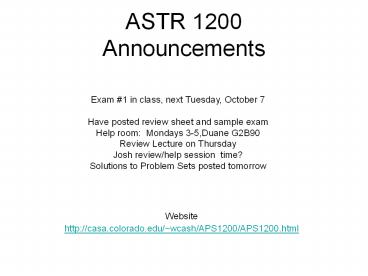ASTR 1200 Announcements - PowerPoint PPT Presentation
Title:
ASTR 1200 Announcements
Description:
... * G Sun, Alpha Centauri A 6,000 K-5,000 K Weak hydrogen lines, ... M Betelgeuse, Proxima Centauri 830 nm (infrared) ... – PowerPoint PPT presentation
Number of Views:106
Avg rating:3.0/5.0
Title: ASTR 1200 Announcements
1
ASTR 1200Announcements
Exam 1 in class, next Tuesday, October 7 Have
posted review sheet and sample exam Help room
Mondays 3-5,Duane G2B90 Review Lecture on
Thursday Josh review/help session
time? Solutions to Problem Sets posted tomorrow
Website http//casa.colorado.edu/wcash/APS1200/AP
S1200.html
2
Planetarium
We met at the planetarium and spent half the time
with a show. In particular, we flew from Earth
to Prox Cen and back, watching theparallax of
the nearby stars. We also flew to Orions
Sword and visited a star-forming region.
3
Electromagnetic Spectrum
- Wavelength increases to the right
- Frequency and energy increase to the left
4
Stars Come in Different Colors
5
Stellar Temperature
Stars come in different sizes and
temperatures. Can the two be linked?
6
Stellar Classification
Full range of surface temperatures from 2000 to
40,000K
Spectral Classification is Based on Surface
Temperature
O B A F G K M
Coolest
Hottest
Girl
Kiss Me
Oh Be A Fine
Guy
Each Letter has ten subdivisions from 0 to 9 0 is
hottest, 9 is coolest
7
The Spectral Types
O Stars of Orion's Belt gt30,000 K Lines of ionized helium, weak hydrogen lines lt97 nm (ultraviolet)
B Rigel 30,000 K-10,000 K Lines of neutral helium, moderate hydrogen lines 97-290 nm (ultraviolet)
A Sirius 10,000 K-7,500 K Very strong hydrogen lines 290-390 nm (violet)
F Polaris 7,500 K-6,000 K Moderate hydrogen lines, moderate lines of ionized calcium 390-480 nm (blue)
G Sun, Alpha Centauri A 6,000 K-5,000 K Weak hydrogen lines, strong lines of ionized calcium 480-580 nm (yellow)
K Arcturus 5,000 K-3,500 K Lines of neutral and singly ionized metals, some molecules 580-830 nm (red)
M Betelgeuse, Proxima Centauri lt3,500 K Molecular lines strong gt830 nm (infrared)
All stars above 6,000 K look more or less white to the human eye because they emit plenty of radiation at all visible wavelengths. All stars above 6,000 K look more or less white to the human eye because they emit plenty of radiation at all visible wavelengths. All stars above 6,000 K look more or less white to the human eye because they emit plenty of radiation at all visible wavelengths. All stars above 6,000 K look more or less white to the human eye because they emit plenty of radiation at all visible wavelengths.
8
Stellar Classification (2)
Sun G2 a Cen G2 K5 Sirius A1 Antares M1 Rigel
B8
O5 40,000K B5 15,500 A5 8500 F5 6580 G5 5520 K5 41
30 M5 2800
Letters are odd due to confusion in sorting out
temperature scale between 1900 and 1920
9
Stellar Classification
Full range of surface temperatures from 2000 to
40,000K
Spectral Classification is Based on Surface
Temperature
O B A F G K M
Coolest
Hottest
Girl
Kiss Me
Oh Be A Fine
Guy
Each Letter has ten subdivisions from 0 to 9 0 is
hottest, 9 is coolest
10
The Spectral Types
Table 15.1 The Spectral Sequence
O Stars of Orion's Belt gt30,000 K Lines of ionized helium, weak hydrogen lines lt97 nm (ultraviolet)
B Rigel 30,000 K-10,000 K Lines of neutral helium, moderate hydrogen lines 97-290 nm (ultraviolet)
A Sirius 10,000 K-7,500 K Very strong hydrogen lines 290-390 nm (violet)
F Polaris 7,500 K-6,000 K Moderate hydrogen lines, moderate lines of ionized calcium 390-480 nm (blue)
G Sun, Alpha Centauri A 6,000 K-5,000 K Weak hydrogen lines, strong lines of ionized calcium 480-580 nm (yellow)
K Arcturus 5,000 K-3,500 K Lines of neutral and singly ionized metals, some molecules 580-830 nm (red)
M Betelgeuse, Proxima Centauri lt3,500 K Molecular lines strong gt830 nm (infrared)
All stars above 6,000 K look more or less white to the human eye because they emit plenty of radiation at all visible wavelengths. All stars above 6,000 K look more or less white to the human eye because they emit plenty of radiation at all visible wavelengths. All stars above 6,000 K look more or less white to the human eye because they emit plenty of radiation at all visible wavelengths. All stars above 6,000 K look more or less white to the human eye because they emit plenty of radiation at all visible wavelengths.
11
Stellar Luminosity
By 1915 had lots of spectra and
classifications Had a few distances from parallax
Once distance was available, luminosity and
Absolute Magnitude could be calculated.
Herzsprung and Russel, working independently both
plotted absolute magnitude (luminosity) vs
classification (temperature)
The H-R Diagram
12
The H-R DiagramPlot of Brightness vs Temperature
-5
Giants
Rigel
Capella
0
Sirius
Brightness
Procyon
Sun
Main Sequence
5
a Cen B
White Dwarfs
10
Sirius B
Prox Cen
15
M
F
K
A
G
O
B
Spectral Type
















![❤[PDF]⚡ 1200 Tic-Tac-Toe Grids PowerPoint PPT Presentation](https://s3.amazonaws.com/images.powershow.com/10085031.th0.jpg?_=20240724054)














